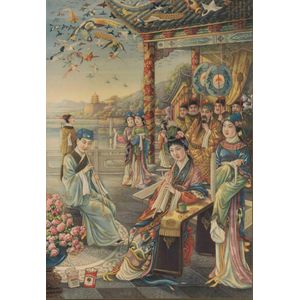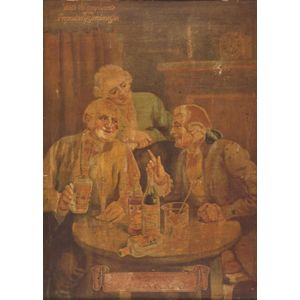Framed Whisky and Gin Bar Posters with Artwork
This site contains only a limited number of works of art sold in Australia and New Zealand, and is not representative of the art market for any artist. For a comprehensive art database visit our specialist site, Australian Art Sales Digest which includes over 400,000 works auctioned in Australia and New Zealand by over 30,000 artists, covering the period from the early 1970s to the present day.
Two framed point of sale bar advertising posters. 'King George IV Whisky' with artwork by Lawson Wood in original oak frames adorned with embossed lettering (45 x 56.5 cm). Plus 'Gordons Gin' poster (37 x 50 cm) (2)
You must be a subscriber, and be logged in to view price and dealer details.
Subscribe Now to view actual auction price for this item
When you subscribe, you have the option of setting the currency in which to display prices to $Au, $US, $NZ or Stg.
This item has been sold, and the description, image and price are for reference purposes only.
- Embossed / Repousse - Embossing, also known as repousse, is the technique of decorating metal with raised designs, by pressing or beating out the design from the reverse side of the object.It is the opposite of chasing, where the decoration is applied from the front. An embossed or repoussed object may have chasing applied to finish off the design.
- George Iv - George IV (1762 ? 1830) was king of the United Kingdom of Great Britain and Ireland and king of Hanover from 1820, until his own death in 1830. From 1811 until his accession in 1820, he served as Prince Regent during his father's final mental illness.
In English furniture design, his reign from 1811 to 1830 is known as the Regency period. - Oak - Native to Europe and England, oak has been used for joinery, furniture and building since the beginning of the medieval civilisation. It is a pale yellow in colour when freshly cut and darkens with age to a mid brown colour.
Oak as a furniture timber was superceded by walnut in the 17th century, and in the 18th century by mahogany,
Semi-fossilised bog oak is black in colour, and is found in peat bogs where the trees have fallen and been preserved from decay by the bog. It is used for jewellery and small carved trinkets.
Pollard oak is taken from an oak that has been regularly pollarded, that is the upper branches have been removed at the top of the trunk, result that new branches would appear, and over time the top would become ball-like. . When harvested and sawn, the timber displays a continuous surface of knotty circles. The timber was scarce and expensive and was used in more expensive pieces of furniture in the Regency and Victorian periods.
This item has been included into following indexes:
Visually similar items

Dudley Hardy (1865-1922), British Dusseldorf Market, 1883, watercolour, signed, dated and titled lower right, 34 x 49.5 cm
Sold by
in
for
You can display prices in $Au, $US, $NZ or Stg.

Spanish School, 17th/18th century, oil on canvas. 137 cm high, 93 cm wide
Sold by
in
for
You can display prices in $Au, $US, $NZ or Stg.

A handworked tapestry scene, the music Lesson
Sold by
in
for
You can display prices in $Au, $US, $NZ or Stg.

A framed Chinese cigarette poster, Republic period, early 20th century, Depicting a male and a female playing flutes for a general in a garden, 48 x 71.5 cm
Sold by
in
for
You can display prices in $Au, $US, $NZ or Stg.
